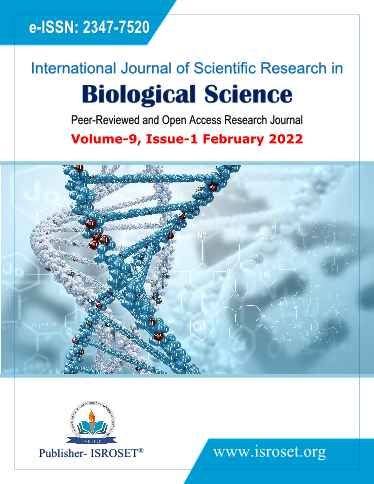A Survey of the Critically Endangered Vultures of Gashaka Gumti National Park, Nigeria
Keywords:
Gyps africanus, Vulture conservation, Protected Areas, Inventory, AbattoirsAbstract
The traditional significance attached to the vultures has made the bird of prey objects of inquests and persecutions by local actors with nonconformist disposition to wildlife conservation in Nigeria. With the ascendancy of wildlife persecutions, vultures are now rare across landscapes and previous information about vulture distribution remain largely altered, outdated and insignificant to guide precise conservation action. Our paper focuses on advancing baseline population statistics for the critically endangered vultures of the project location. From the eight (8) survey routes objectively allotted for data collection, Route 3 (Pompo 2A – Mayo-Yum) had the highest record of 21 individuals (30%) of Necrosyrtes monachus, while Route 1 (Gashaka –GF/Kwano - Filinga), had 13 individuals (92%) of the Gyps africanus recorded during the inventory. Across all the survey routes, 71 and 14 individuals of N. monachus and G. africanus, respectively, were sighted and enumerated. Thus, an overall unadjusted count of 85 individuals from two (2) species of the Critically Endangered (CE) vultures were encountered and recorded within Gashaka Gumti National Park and the support zone communities. The Park has, therefore, great potentials for the conservation of vultures considering its vast landmass of about 6,730 sq.km, the spread of pastoral settlements and diversity of local tribes. However, due to the low sampling intensity (< 1%) and several exploratory sightings of unnamed species of vultures by locals, complementary surveys are required to update existing records of vultures in the park. The park is significant to upholding vulture biodiversity at the habitat-level in Nigeria.
References
M.M. Williams, U. Ottosson, T. Tende, J.P. Deikumah, “Traditional belief systems and trade in vulture parts are leading to the eradication of vultures in Nigeria: an ethno-ornithological study of north-central Nigeria”. Ostrich, doi 10.2989/00306525.2021.1929534, 2021.
D.H. Ellis, R.L. Glinski, D.G. Smith, “Raptor Road Surveys in South America”. J. Raptors Res. Vol. 24, No.4, pp98-106, 1990.
D.L. Ogada, R. Buij, “Decline of the Hooded Vulture Necrosyrtes monachus across its African range”. Ostrich – J. Afri Ornith, Vol. 82, No.2, pp101-113. doi:10.2989/00306525.2011.603464, 2011.
D. Ogada, P. Shaw, R.L. Beyers, R. Buij, C. Murn, J.M. Thiollay, “Another continental vulture crisis: Africa’s vultures collapsing toward extinction”. Conserv. Lett. Vol. 9, No.2, pp89–97, 2016.
J.M. Thiollay, “Decline of African vultures: a need for studies and conservation”. Ostrich, Vol. 88, No.2. doi:10.2989/00306525.2017.1326004, 2017.
B.O. Kankam, H. Abukari, “Predicting residents` intention to conserve the hooded vulture (Necrosyrtes monachus) in the Birem North District, Ghana”. Heliyon, Vol. 6, No.9, https://doi.org/10.1016/j.heliyon.2020.e04966, 2020.
R. Buij, G. Nikolaus, R. Whytock, D.J. Ingram, D. Ogada, “Trade of threatened vultures and other raptors for fetish and bushmeat in West and Central Africa”. Oryx, Vol. 50, No.1, pp606–616, https://doi.org/10.1017/ S003060531500051, 2015.
C. Kremen, A.M. Merenlender, D.D. Murphy, “Ecological monitoring: a vital need for integrated conservation and development programs in the tropics”. Conservation Biology, Vol.8, No.1, pp1–10. 1994.
A.J. Plumptre, “Monitoring mammal populations with line transect techniques in African forests”. Journal of Applied Biology, Vol. 37, No.2, pp356-368, doi.org/10.1046/j.1365-2664.2000.00499.x. 2002.
J.D. Onoja, T. Tende, T, T.C. Omotoriogun, U. Ottosson, S.A. Manu, G.S. Mwansat, “Raptors in Yankari Game Reserve and surrounding unprotected area, Nigeria”. Malimbus, Vol. 36, Vol.1, pp67-75. 2014.
N.D. Muhammad, Z.K. Mustapha, “Collapsing towards Extinction? Trade in Birds Carcasses for Traditional Medicine and the Decline of Vulture Population in Katsina State”. Nigeria. J. Appl. Sci. Environ. Manage., Vol. 24, No.4, pp575- 580. dx.doi.org/10.4314/jasem.v24i4.5. 2020.
K.L. Adang, D. Tanko, K.L Saliu, U.A. Abdulwahab, “Breeding Record of the Hooded Vulture Necrosyrtes monachus (Timminek, 1823) at Emi Abumo Woro, Kogi State, Nigeria”. Asian Journal of Biological Sciences, 12: 222-230. doi:10.3923/ajbs.2019.222.230, 2019.
A.M. Mubi, “Remote Sensing-Gis Supported Land Cover Analysis of Gashaka-Gumti National Park, Nigeria”. FUTY J. of the Envt, Vol. 5, No.1, 2010.
S. Aina, M. Awoniyi, S. Udo-Azugo, N. Omeje, “Assessments of land cover dynamics for conservation planning in Gashaka Gumti national park, Nigeria”. Discovery Nature, Vol. 12, No.1, pp82-90, 2018.
J. Mawdo, C. R. Barlow, L. Sanyang, L. Dibba, C. Kendall, M. Bechard, K.L. Bildstein, “High population density of the Critically Endangered Hooded Vulture Necrosyrtes monachus in Western Region, The Gambia, confirmed by road surveys in 2013 and 2015”. Malimbus, Vol. 38, No.1, pp23-28, 2016.
C.E. Shannon, W. Weaver, “The Mathematical Theory of Communication”. University of Illinois Press, Urbana, Illinois. 144pp, 1949.
K.A. Nolan, J.E. Callahan. “Beachcomber biology: The Shannon-Weiner Species Diversity Index”. In the proceedings of the 27th Workshop/Conference of the Association for Biology Laboratory Education on Tested Studies for Laboratory Teaching, (M.A. O`Donnell, Editor), Vol. 27, pp334-338, 2006.
S. Keren, M. Svoboda, P. Janda, T.A. Nagel, “Relationships between Structural Indices Conventional Stand Attributes in an Old-Growth Forest in Southeast Europe”. Forests, Vol. 11, No.4: doi:10.3390/f11010004, 2019.
D. Keeping, R. Pelletier, “Animal Density and Track Counts: Understanding the Nature of Observations Based on Animal Movements”. PLoS ONE, Vol. 9, No.5, e96598. doi.org/10.1371/journal.pone.0096598. 2014.
A.J. Botha, J. Andevski, C.G.R. Bowden, M. Gudka, R.J. Safford, J. Tavares, N.P. Williams, “Multi-species Action Plan to Conserve African-Eurasian Vultures”. CMS Raptors MOU Technical Publication No. 5. CMS Technical Series No. xx. Coordinating Unit of the CMS Raptors MOU, Abu Dhabi, United Arab Emirates, 2017.
V. Lepetz, M. Massot, D.S. Schmeller, J. Clobert, “Biodiversity monitoring: some proposals to adequately study species’ responses to climate change”. Biodiversity and Conservation, Vol. 18, No.1, pp3185-3203. doi: 10.1007/s10531-009-9636-0. 2009.
D. Schmeller, K. Henle, A. Loyau, A. Besnard, P. Henry, “Bird-monitoring in Europe – a first overview of practices, motivations and aims”. Nature Conservation, Vol.2, No.1, pp41-57. doi.org/10.3897/natureconservation.2.3644, 2012.
Downloads
Published
How to Cite
Issue
Section
License

This work is licensed under a Creative Commons Attribution 4.0 International License.
Authors contributing to this journal agree to publish their articles under the Creative Commons Attribution 4.0 International License, allowing third parties to share their work (copy, distribute, transmit) and to adapt it, under the condition that the authors are given credit and that in the event of reuse or distribution, the terms of this license are made clear.







